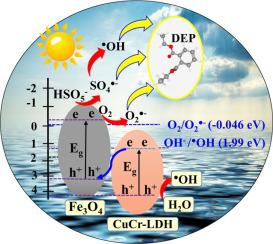Applied Surface Science ( IF 6.3 ) Pub Date : 2021-05-02 , DOI: 10.1016/j.apsusc.2021.149906 Arezou Fazli , Marcello Brigante , Alireza Khataee , Gilles Mailhot

|
Herein, a stable and S-scheme Fe3O4@CuCr-LDH nanocomposite was synthesized and used for the photocatalytic degradation of diethyl phthalate (DEP) through the activation of peroxymonosulfate (PMS). In comparison with pure Fe3O4, and LDH, the Fe3O4@CuCr-LDH nanocomposite demonstrated significantly enhanced photocatalytic activity due to its S-scheme charge-carrier migration mechanism. The prepared composite was also magnetically recoverable from the treated water which is favorable to avoid the production of secondary pollution. The integration of the composite and visible light showed the presence of a synergy factor of 14 for the degradation of diethyl phthalate. However, the photocatalytic performance of Fe3O4@CuCr-LDH was dependent on the different physicochemical parameters; wherein, the higher degradation efficiency was achieved using the solution pH of 8, the catalyst, DEP, and PMS concentrations of 1 g L−1, 20 mg L−1, and 8 mM, respectively. The high photocatalytic activity of the catalyst was maintained after 5 consecutive reaction runs and the stability of the material was proved by the XPS. Moreover, the ICP-AES analysis proved that the leaching of Fe, Cr, and Cu is lower than the standard concentration in the drinking water. Finally, the mineralization ability and the decreased toxicity of the treated solution of DEP were assessed.
中文翻译:

磁性可分离的基于LDH的S方案纳米异质结的合成,用于活化过氧单硫酸盐朝邻苯二甲酸二乙酯的有效可见光光降解
在此,合成了稳定的S型Fe 3 O 4 @ CuCr-LDH纳米复合材料,并通过过氧单硫酸盐(PMS)的活化将其用于邻苯二甲酸二乙酯(DEP)的光催化降解。与纯Fe 3 O 4和LDH相比,Fe 3 O 4@ CuCr-LDH纳米复合材料由于其S型电荷载流子迁移机制而表现出显着增强的光催化活性。所制备的复合材料还可以从处理后的水中以磁性方式回收,这有利于避免产生二次污染。复合材料和可见光的结合表明存在用于降解邻苯二甲酸二乙酯的协同因子14。然而,Fe 3 O 4 @ CuCr-LDH的光催化性能取决于不同的理化参数。其中,使用8的溶液pH,1 g L -1,20 mg L -1的催化剂,DEP和PMS浓度可获得更高的降解效率,分别为8 mM。连续5次反应运行后,催化剂保持了高光催化活性,并且XPS证明了材料的稳定性。此外,ICP-AES分析证明,Fe,Cr和Cu的浸出低于饮用水中的标准浓度。最后,评估了DEP处理溶液的矿化能力和降低的毒性。











































 京公网安备 11010802027423号
京公网安备 11010802027423号